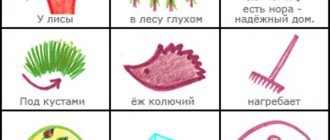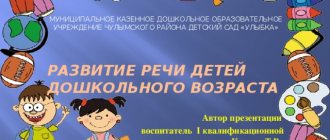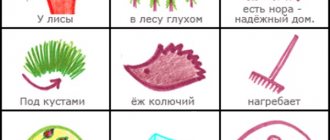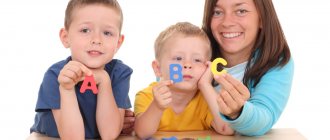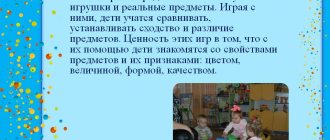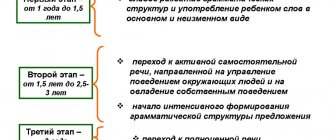Speech plays an important role in the psychological and social development of a child. Violations in this area lead to a slowdown in the formation of cognitive processes, difficulties in mastering the school curriculum, and make the child withdrawn and indecisive.
To minimize the likelihood of such problems occurring, it is necessary to know the methods of speech development in preschool children.
Stages of speech development in children from birth to school
Human speech develops in stages. Its formation begins from birth. Russian psychologist and linguist Alexey Leontiev identified a number of important stages of speech formation that a child goes through: preparatory, pre-school and pre-school.
The preparatory period covers the period of time from birth to one year, it is divided into 3 stages:
- scream _ With its help, the newborn communicates with the people around him. This is the first vocal reaction. The child uses it to tell his mother about his discomfort. Thanks to screaming, articulation, voice, and breathing are trained;
- revelry _ Lasts until six months of age. The baby reproduces certain sounds and their variations (a-gy, boo-oo, a-gu). At this stage, it is important to support the child's desire to communicate. To do this, parents should repeat what the baby says;
- babble _ This stage lasts up to a year. It is the final stage of preparing the baby for full speech. Children begin to pronounce repeated syllables (ma-ma, va-va, ba-ba, yes-da, pa-pa). At first, the child pronounces simple words unconsciously. But by 10-12 months, children begin to meaningfully use “ma-ma”, “ba-ba”, etc.
The pre-school stage begins when infants begin to consciously pronounce their first words. It lasts from 12 months to 3 years. Children's first words are general in nature. For example, “give” can mean a request, a desire, or an object. Therefore, only family members understand the baby for now.
From the age of one and a half years, children begin to pronounce words in full, and not in a truncated form. The lexicon continues to expand. Kids try to put simple words into sentences without prepositions. For example, “Masha am-am” means that Masha is hungry. By the age of three, questions are formulated in speech: “How?”, “Where?”, “Where?”, “When?”.
Children under three years old actively use gestures
The child learns to use prepositions, agree words in case, number, gender. Four-year-old children already communicate using complex and compound sentences. The preschool stage of speech formation lasts from 3 to 7 years. This is a time of active replenishment of the vocabulary.
By the end of the preschool period, children pronounce all sounds correctly and have a broad outlook.
Methods of speech development in kindergarten
The theory and methodology of speech development in preschool children has its own characteristics. There are many techniques for teaching kids. One of the most popular is the method of Alekseeva M.M. and Yashina V.I.
The technique involves step-by-step speech training:
- filling the vocabulary;
- correct sound reproduction;
- grammatical construction of sentences;
- training in conducting monologues and dialogues.
In the method of speech development by V.I. Yashina. The following methods are used:
- verbal (carried out through conversations, reading, stories);
- visual (implemented through examination of objects, familiarization with drawings, photographs);
- practical (these are theatrical games, drawing, designing, round dances).
Methods of speech development by Yashina V.I. and Alekseeva M.M. involves the use of such verbal techniques:
- speaking;
- sample of speech communication;
- repetition;
- indication;
- explanation;
- question.
Reading fairy tales and short stories is a great way to improve your vocabulary
Groups in preschool educational institutions are divided into junior, middle and senior. The thoughtful speech of a specialist is used as a role model. To motivate the child to actively communicate, the teacher emphasizes his positive qualities and achievements. It is customary to correct vocabulary errors correctly and accurately.
In younger groups
The method of developing children's speech involves mastering words, understanding their meaning, and association. In younger groups, as a rule, classes are conducted in the form of a game. Memorizing words occurs when studying the world around us, looking at drawings, toys and other objects.
At this time, the teacher pronounces sounds, associating them with a specific object. Auditory exercises alternate with articulation exercises. To train the speech apparatus, the teacher asks the children to smile, stick out their tongue, run it over their upper teeth, and then puff out their cheeks.
The method for three-year-old children is aimed at teaching the correct pronunciation of sounds. Children learn to hear and pronounce consonants and vowels. Children often confuse hissing and dull sounds and miss them.
In kindergartens, deduction games are often played: “Brew tea”, “Guess what they hid”, “Cut salad”, etc. During such activities, the child learns not only to talk, but also to perform actions with objects. Also, the teacher’s task is to create associations for the correct formation of speech. For this purpose, quantity games are played.
In middle and senior groups
In the middle and older groups, a method for comparing and correcting speech disorders is used. Repeated repetition of a verbal element gives the child the opportunity to remember the sound and learn to pronounce it correctly. The teacher explains the essence and meaning of various phenomena and objects. This allows you to remember words faster.
The specialist’s task is to consolidate the acquired skills and form conversational speech in the child. Kids are encouraged to conduct a coherent dialogue, listen and maintain a conversation. Simple lessons on relationships and sentence structure are taught.
To construct morphological speech, the following techniques are used:
- reading literature;
- learning poetry;
- staging theatrical scenes.
Methods of speech development by Starodubova N.A. involves conducting collective training sessions aimed at developing perseverance, assessing speech level, and creative qualities. In middle and senior kindergarten groups, children communicate a lot with their peers, use speech patterns and skills. Participation in games for older children contributes to the rapid development of speech.
But such an association must take place under the control of educators. After all, some older guys can tease and offend kids, laughing at their still unpracticed speech. This negatively affects the development process. Children's vocabulary is replenished through descriptive stories. The methodological system makes it possible to develop imagination and memory.
Games described include:
- examination of the subject;
- highlighting its special features;
- determining the components of an object relative to each other;
- finding small components;
- re-perception.
Six-year-old children should be able to recreate images of things in their memory when answering questions from the teacher. Kids are able to rhyme words, compose simple rhymes, and compose logically meaningful stories.
The purpose and objectives of children's speech development
The main goal of work on speech development and teaching children their native language is the formation of oral speech and verbal communication skills with others based on mastering the literary language of their people.
In the domestic methodology, one of the main goals of speech development was considered to be the development of the gift of speech, i.e. the ability to express precise, rich content in oral and written speech (K. D. Ushinsky).
For a long time, when characterizing the goal of speech development, such a requirement for a child’s speech as its correctness was especially emphasized. The task was “to teach children to speak their native language clearly and correctly, i.e. freely use the correct Russian language in communicating with each other and adults in various activities typical of preschool age.” Correct speech was considered as: a) correct pronunciation of sounds and words; b) correct use of words; c) the ability to correctly change words according to the grammar of the Russian language (See; Solovyova O.I. Methodology for the development of speech and teaching the native language in kindergarten. - M., 1960. - P. 19–20.)
This understanding is explained by the then generally accepted approach in linguistics to the culture of speech as its correctness. At the end of the 60s. in the concept of “culture of speech” two sides began to be distinguished: correctness and communicative expediency (G. I. Vinokur, B. N. Golovin, V. G. Kostomarov, A. A. Leontyev). Correct speech is considered necessary, but a lower level, and communicative and expedient speech is considered the highest level of mastery of a literary language. The first is characterized by the fact that the speaker uses linguistic units in accordance with the norms of the language, for example, without socks (and not without socks), putting on a coat (and not wearing them), etc. But correct speech can be poor, with a limited vocabulary, with monotonous syntactic structures . The second is characterized as the optimal use of language in specific communication conditions. This refers to the selection of the most appropriate and varied ways of expressing a certain meaning. School methodologists, in relation to school practice of speech development, called this second, highest level good speech (See: Methods of speech development in Russian language lessons / Edited by T. A. Ladyzhenskaya. - M., 1991.)
Signs of good speech are lexical richness, accuracy, and expressiveness.
This approach, to a certain extent, can be used in relation to preschool age; moreover, it is revealed when analyzing modern kindergarten programs and methodological literature on the problems of speech development of children. Speech development is considered as the formation of skills and abilities of precise, expressive speech, free and appropriate use of language units, and adherence to the rules of speech etiquette. Experimental studies and work experience indicate that by older preschool age children can master not only correct, but also good speech.
Consequently, in modern methods, the goal of the speech development of preschool children is the formation of not only correct, but also good oral speech, of course, taking into account their age characteristics and capabilities.
The general task of speech development consists of a number of private, special tasks. The basis for their identification is the analysis of forms of speech communication, the structure of language and its units, as well as the level of speech awareness. Research into speech development problems in recent years, conducted under the leadership of F. A. Sokhin, has made it possible to theoretically substantiate and formulate three aspects of the characteristics of speech development problems: structural (formation of different structural levels of the language system - phonetic, lexical, grammatical); functional, or communicative (formation of language skills in its communicative function, development of coherent speech, two forms of verbal communication - dialogue and monologue); cognitive, cognitive (formation of the ability to basic awareness of the phenomena of language and speech).
Let us visualize the identification of the tasks of children’s speech development.
| Basic units of language | Forms of verbal communication | Speech development tasks |
| Word | 1 Dictionary development | |
| Sound | 2 Education of sound culture of speech | |
| Word form Collocation Sentence | 3 Formation of grammatical structure of speech | |
| Text | Dialogue Monologue | 4 Development of coherent speech a) the formation of dialogic (conversational) speech, b) the formation of monologue speech |
Let us briefly look at the characteristics of each task. Their content is determined by linguistic concepts and psychological characteristics of language acquisition.
1. Vocabulary development.
Mastering vocabulary is the basis of children's speech development, since the word is the most important unit of language. The dictionary reflects the content of speech. Words denote objects and phenomena, their signs, qualities, properties and actions with them. Children learn the words necessary for their life and communication with others.
The main thing in the development of a child's vocabulary is mastering the meanings of words and their appropriate use in accordance with the context of the statement, with the situation in which communication takes place.
Vocabulary work in kindergarten is carried out on the basis of familiarization with the surrounding life. Its tasks and content are determined taking into account the cognitive capabilities of children and involve mastering the meanings of words at the level of elementary concepts. In addition, it is important that children master the compatibility of a word, its associative connections (semantic field) with other words, and features of use in speech. In modern methods, great importance is attached to the development of the ability to choose the most appropriate words for a statement, to use polysemantic words in accordance with the context, as well as to work on lexical means of expression (antonyms, synonyms, metaphors). Vocabulary work is closely related to the development of dialogic and monologue speech.
2. Nurturing the sound culture of speech is a multifaceted task, which includes more specific microtasks related to the development of perception of the sounds of native speech and pronunciation (speaking, speech pronunciation).
It involves: the development of speech hearing, on the basis of which the perception and discrimination of phonological means of language occurs; teaching correct sound pronunciation; education of orthoepic correctness of speech; mastering the means of sound expressiveness of speech (tone of speech, timbre of voice, tempo, stress, voice strength, intonation); developing clear diction. Much attention is paid to the culture of speech behavior. The teacher teaches children to use means of sound expressiveness, taking into account the tasks and conditions of communication.
Preschool childhood is the most favorable period for developing the sound culture of speech. Mastery of clear and correct pronunciation should be completed in kindergarten (by age five).
3. The formation of the grammatical structure of speech involves the formation of the morphological side of speech (changing words by gender, number, cases), methods of word formation and syntax (mastering different types of phrases and sentences). Without mastering grammar, verbal communication is impossible.
Mastering grammatical structure is very difficult for children, since grammatical categories are characterized by abstractness and abstraction. In addition, the grammatical structure of the Russian language is distinguished by the presence of a large number of unproductive forms and exceptions to grammatical norms and rules.
Children learn grammatical structure practically, by imitating the speech of adults and linguistic generalizations. In a preschool institution, conditions are created for mastering difficult grammatical forms, developing grammatical skills and abilities, and preventing grammatical errors. Attention is paid to the development of all parts of speech, the development of different methods of word formation, and various syntactic structures. It is important to ensure that children freely use grammatical skills and abilities in verbal communication, in coherent speech.
4. The development of coherent speech includes the development of dialogic and monologue speech.
a) Development of dialogic (conversational) speech. Dialogue speech is the main form of communication among preschool children. For a long time, the methodology has been discussing the question of whether it is necessary to teach children dialogic speech if they master it spontaneously in the process of communicating with others. Practice and special research show that preschoolers need to develop, first of all, those communicative and speech skills that are not formed without the influence of an adult. It is important to teach a child to conduct a dialogue, develop the ability to listen and understand speech addressed to him, enter into a conversation and support it, answer questions and ask himself, explain, use a variety of language means, and behave taking into account the communication situation.
It is equally important that in dialogic speech the skills necessary for a more complex form of communication – monologue – are developed. A monologue arises in the depths of a dialogue (F. A. Sokhin).
b) The development of coherent monologue speech involves the formation of the skills to listen and understand coherent texts, retell, and construct independent statements of different types. These skills are formed on the basis of basic knowledge about the structure of the text and the types of connections within it.
5. The formation of an elementary awareness of the phenomena of language and speech ensures the preparation of children for learning to read and write.
“In the pre-school group, speech for the first time becomes a subject of study for children. The teacher develops in them an attitude towards oral speech as a linguistic reality; he leads them to the sound analysis of words.” Children are also taught to perform syllabic analysis of words and analysis of the verbal composition of sentences. All this contributes to the formation of a new attitude towards speech. Speech becomes the subject of children’s awareness (Solovieva O.I. Methods of speech development and teaching the native language in kindergarten. - M., 1966. - P. 27.)
But speech awareness is not only associated with preparation for literacy. F.A. Sokhin noted that work aimed at basic awareness of the sounds of speech and words begins long before the preparatory group for school. When learning correct sound pronunciation and developing phonemic hearing, children are given tasks to listen to the sound of words, find the most frequently repeated sounds in several words, determine the location of a sound in a word, and remember words with a given sound. In the process of vocabulary work, children perform tasks to select antonyms (words with the opposite meaning), synonyms (words that are similar in meaning), and look for definitions and comparisons in the texts of works of art. Moreover, an important point is the use of the terms “word” and “sound” in the formulation of tasks. This allows children to form their first ideas about the distinction between words and sounds. In the future, in preparation for learning to read and write, “these ideas deepen, since the child isolates the word and sound precisely as units of speech, has the opportunity to “hear” their separateness as part of the whole (sentences, words) (Sokhin F.A. Tasks of speech development// Speech development of preschool children / Edited by F. A. Sokhin. - M., 1984. - P. 14.)
Awareness of the phenomena of language and speech deepens children’s observations of language, creates conditions for self-development of speech, and increases the level of control over speech. With appropriate guidance from adults, it helps to foster interest in discussing linguistic phenomena and love for the native language.
In accordance with the traditions of Russian methodology, another task is included in the range of tasks for speech development - familiarization with fiction, which is not speech in the proper sense of the word. Rather, it can be considered as a means of accomplishing all the tasks of developing a child’s speech and mastering language in its aesthetic function. The literary word has a huge impact on the education of the individual and is a source and means of enriching children’s speech. In the process of introducing children to fiction, the vocabulary is enriched, figurative speech, poetic ear, creative speech activity, aesthetic and moral concepts are developed. Therefore, the most important task of a kindergarten is to cultivate in children an interest and love for the artistic word.
The identification of speech development tasks is conditional; when working with children, they are closely related to each other. These relationships are determined by objectively existing connections between different units of language. By enriching, for example, the dictionary, we simultaneously make sure that the child pronounces words correctly and clearly, learns their different forms, and uses words in phrases, sentences, and in coherent speech. The interrelation of different speech tasks based on an integrated approach to their solution creates the prerequisites for the most effective development of speech skills and abilities.
At the same time, the central, leading task is the development of coherent speech. This is explained by a number of circumstances. Firstly, in coherent speech the main function of language and speech is realized - communicative (communication). Communication with others is carried out precisely with the help of coherent speech. Secondly, in coherent speech the relationship between mental and speech development is most clearly evident. Thirdly, coherent speech reflects all other tasks of speech development: the formation of vocabulary, grammatical structure, and phonetic aspects. It shows all the child’s achievements in mastering his native language.
The teacher’s knowledge of the content of the tasks is of great methodological importance, since the correct organization of work on speech development and teaching the native language depends on it.
Ushakova's technique
Ushakova’s method for developing the speech of preschool children is quite well-known and effective. It is based on the assimilation of simple material and elementary techniques, followed by a transition to more difficult classes.
Complicating tasks for the baby is carried out gradually and imperceptibly. After just four lessons you can see positive results in speech development.
Parents play a major role in the development of a baby’s speech, so mothers are given the following recommendations:
- talk to your child correctly;
- ask the baby to repeat simple words;
- during the game, name objects;
- regularly tell fairy tales, read children’s books aloud;
- If the child pronounces words incorrectly, try to correct the mistakes.
Ushakova’s technique involves an individual approach. When developing the program, the health characteristics, genetics, level of development, age of the baby, his skills and abilities are taken into account.
Theoretical foundations of speech development in preschool children
Theoretical foundations of speech development in preschool children
The process of speech development and learning the native language is a complex and multifaceted phenomenon. A scientifically based methodology should be based on an understanding of both the essence and distinctive features of language and the speech mechanism, knowledge of the patterns and features of the development of various aspects of speech, skills and abilities of verbal communication. Therefore, the theoretical basis for the method of speech development consists of data from a number of sciences: physiology, theory of knowledge, psychology. Linguistics, psycholinguistics, students of language, speech, speech activity.
The methodological basis for teaching the native language is the provisions of materialist philosophy about language as a product of socio-historical development, as the most important means of communication and social interaction of people, about its connection with thinking. Language and speech arose in activity and are one of the conditions for human existence and the implementation of his activities. Language, as a product of this activity, reflects its conditions, content, and result. This determines the most important principle of the methodology - mastery of language forms, development of speech and communication skills in children occurs in activity, and the driving force of development is the need for communication that arises in the process of this activity. The second characteristic of the methodology is its definition as the most important means of human communication and social interaction. Without language, truly human communication, and therefore the development of speech, is fundamentally impossible.
In the process of communication, the child does not passively accept the adult’s speech patterns, but actively appropriates speech as part of the universal human experience.
A methodological characteristic of language is its relationship with thinking. Language is a tool of thinking and cognition. It makes planning of intellectual activity possible. Language is a means of expressing thoughts. Speech is seen as a way of formulating thoughts through language. At the same time, thinking and speech are not identical concepts. Thinking is the highest form of active reflection of objective reality.
Language directly reflects and consolidates the specifically human – a generalized reflection of reality. Both of these concepts form a complex dialectical unity, each of which has its own specifics. Identification and description of the relationship between language and thinking make it possible to determine more targeted and accurate methods for the development of speech and thinking.
Teaching the native language is considered as the most important means of mental education. Only that method of speech development is recognized as effective, which simultaneously develops thinking.
In the development of speech, the accumulation of its content comes first. The content of speech is ensured by the connection between the process of language acquisition and the process of cognition of the surrounding world. Language is a means of logical cognition; the development of a child’s thinking abilities is associated with mastery of language.
The natural scientific basis of the methodology is the teaching of I.P. Pavlova about two signaling systems of human higher nervous activity, explaining the mechanisms of speech formation. The physiological basis of speech is the temporary connections formed in the cerebral cortex as a result of the impact on a person of objects and phenomena of reality and the words with which these objects and phenomena are designated. I.P. Pavlov considered speech as kinesthetic impulses going to the cortex from the speech organs. He called these kinesthetic sensations the main basal component of the second signaling system. The process of mastering speech is based on the interaction of direct and speech reflection of the external world, the process of interaction of immediate and speech reactions.
Research by A.G. Ivanov-Smolensky, N.I. Krasnogorsky, M.M. Koltsova and others help to understand the process of development of the second signaling system in children in its unity with the first signaling system. M. M. Koltsova notes in her research that the word acquires the role of a conditioned stimulus for the child at the 8-9th month of his life. The formation of motor speech depends not only on communication, but also, to some extent, on the motor sphere. A special role belongs to the small muscles of the hands and, consequently, to the development of fine movements of the fingers.
The psychological basis of the methodology is the theory of speech and speech activity, formulated in the works of L. S. Vygotsky, S. L. Rubinstein, D. B. Elkonin, A. A. Leontyev, F. A. Sokhin, A. M. Shakhnarovich. “Speech activity is an active, purposeful process, mediated by the language system and determined by the situation, the process of receiving and transmitting messages” (I. A. Zimnyaya).
Summarizing the views of domestic psychologists on the patterns of speech development of preschool children, we can present them as follows:
1. The child’s speech develops as a result of generalization of linguistic phenomena, perception of adult speech and his own speech activity;
2. Language and speech are considered as the core located at the center of various lines of mental development: thinking, imagination, memory, emotions;
3. The leading direction in teaching the native language is the formation of linguistic generalizations, elementary awareness of the phenomena of language and speech;
4. The child’s orientation in linguistic phenomena creates conditions for independent observations of language and for speech self-development;
5. The process of speech development is not a process of quantitative changes, expressed in an increase in vocabulary and associative connections of a word, but a process of qualitative changes, leaps, i.e. this is a process of actual development, which, being internally connected with the development of thinking and consciousness, covers all the listed functions, aspects and connections of the word. (A. N. Leontyev).
These characteristics of speech indicate the need for teachers to pay more attention to the content, conceptual side of linguistic phenomena, to language as a means of expression, formation and existence of thought, to the holistic development of all functions and forms of speech.
For our problem, it is important to determine language ability, which is a set of speech skills and abilities formed on the basis of innate prerequisites. Speech skill is a speech action that has reached a degree of perfection, the ability to optimally carry out one or another operation.
Speech skill is a speech action that has reached a degree of perfection, the ability to optimally carry out one or another operation. Speech skills include: skills in the design of linguistic phenomena (external design - pronunciation, division of phrases, intonation; internal - choice of case, gender, number).
Speech skill is a special human ability that becomes possible as a result of the development of speech skills.
A.A. Leontyev believes that skills are “the formation of speech mechanisms,” and skill is the use of these mechanisms for various purposes.”
The method of speech development is based not only on the general psychological theory of speech, but also on data from child psychology, which studies the patterns and characteristics of the mental and speech development of children at different stages of preschool childhood, the possibility of children mastering different functions and forms of speech.
The problems of teaching the native language and speech development in preschool childhood are revealed in the works of L.S. Vygotsky, S.L. Rubinstein, A.N. Leontyev, D.B. Elkonina, M.I. Lisina, F.A. Sokhina.
Psychological research makes it possible to understand how various mental processes occur in a child, how perception and production of speech utterances occur, what are the features of mastering different aspects of speech, and determine the degree of accessibility and appropriateness of the content, methods and techniques of teaching.
The linguistic basis of this problem is the doctrine of language as a sign system.
It is impossible to teach a language without taking into account its specifics. The learning process should be based on an understanding of the essence and distinctive features of linguistic phenomena. Linguistics considers language as a system in the unity of all its levels: phonetic, lexical, word-formation, morphological, syntactic.
Taking into account systemic connections in language and speech helps determine an approach to solving many methodological issues. Work on speech development is also a complex system, reflecting in its content and methodology the systematic nature of linguistic connections. The most important principle of teaching the native language is complexity, the solution of all problems of speech development in interrelation and interaction, with the leading role of coherent speech. The practical solution to the issues of teaching the native language largely depends on understanding the relationship between language and speech. “Language is a system of objectively existing, socially assigned signs that correlate conceptual content and typical sound, as well as a system of rules for their use and compatibility.” (Linguistic encyclopedic dictionary).
Speech is a psychophysiological process, it is the implementation of language, which only through speech fulfills its communicative purpose. Language is a means of communication, and speech is the process of communication itself. Language is abstract and reproducible, objective in relation to the speaker. Speech is concrete and unique, material, consists of articulated signs perceived by the senses, dynamic, subjective, and is a type of free creative activity of the individual. (Linguistic Dictionary).
The development of modern linguistics deepens the linguodidactic foundations of the methodology. Recently, based on the linguistics of the text, the methodology of coherent speech has been refined and developed from the standpoint of categorical features of the text, the theory of functional-semantic types of utterances. Various sciences of the linguistic cycle - lexicology, phraseology, phonetics, grammar - make it possible to determine the main directions of work, the composition of speech skills and methods of their formation. Thus, phonetics serves as the basis for developing methods for educating the sound culture of speech and preparing for learning to read and write; text linguistics is necessary for the proper organization of teaching coherent speech; knowledge of grammar is a technique for developing morphological, word-formation and syntactic skills.
The method of speech development is closely related to the method of initial teaching of the native language. These are two branches of methods of teaching the native language. The connection between them is especially evident in the field of preparation for learning to read and write, in establishing continuity in the development of children’s speech in kindergarten and school.
Currently, this science is an integrative discipline that examines the linguistic, psychophysiological, psycholinguistic, and didactic foundations of speech development in preschool children.
The system of work on speech development is a complex formation, including such interconnected and interacting components as: the goal and objectives of children’s speech development; content of work on the development of different aspects of speech; general didactic and methodological principles of teaching speech; means and organizational forms of speech education; methods and techniques for developing communicative and speech skills; diagnostics of children's speech development. The main goal of work on speech development and teaching children their native language is the formation of oral speech and verbal communication skills with others based on mastering the literary language of their people.
In the domestic methodology, one of the main goals of speech development was considered to be the development of the gift of speech, that is, the ability to express precise, rich content in oral and written speech (K.D. Ushinsky)
For a long time, when characterizing the goal of speech development, such a requirement for a child’s speech as its correctness was especially emphasized. The task was set “to teach children to speak their native language clearly and correctly, to freely use the correct Russian language in communicating with each other and adults in various activities typical of preschool age
Correct speech was considered as:
a) correct pronunciation of sounds and words;
b) correct use of words;
c) the ability to correctly change words according to the grammar of the Russian language.
This understanding is explained by the then generally accepted approach in linguistics to the culture of speech as its correctness.
At the end of the 60s. in the concept of “culture of speech” two sides began to be distinguished: correctness and communicative expediency (G. I. Vinokur, B. N. Golovin, V. G. Kostomarov, A. A. Leontyev).
Correct speech is considered necessary, but a lower level, and communicative and expedient speech is considered the highest level of mastery of a literary language. The first is characterized by the fact that speakers use linguistic units in accordance with the norms of the language, for example, without socks (and not without socks), put on a coat (and not put on). But correct speech can be poor, with a limited vocabulary, with monotonous syntactic structures. The second is characterized as the optimal use of language in specific communication conditions. This refers to the selection of the most appropriate and varied ways of expressing a certain meaning. School methodologists, in relation to school practice of speech development, called this second, highest level good speech.
Signs of good speech are lexical richness, accuracy, expressiveness (Alekseeva M.M., Yashina V.I., 1998). This approach, to a certain extent, can be used in relation to preschool age. Consequently, in modern methods, the goal of the speech development of preschool children is the formation of not only correct, but also good oral speech, of course, taking into account their age characteristics and capabilities. The general task of speech development consists of a number of private, special tasks.
The basis for their identification is the analysis of forms of speech communication, the structure of language and its units, as well as the level of speech awareness. Research into speech development problems in recent years, conducted under the leadership of F. A. Sokhin, has made it possible to theoretically substantiate and formulate three aspects of the characteristics of speech development problems:
— structural (formation of different structural levels of the phonetic, lexical, grammatical language system);
- functional, or communicative (formation of language skills in its communicative function, development of coherent speech, two forms of verbal communication - dialogue and monologue);
- cognitive, cognitive (formation of the ability to basic awareness of the phenomena of language and speech).
2. Methodology for forming a dictionary in children of primary preschool age The structure of work with younger preschoolers is aimed at expanding, clarifying and activating the dictionary. Part of the work on speech development in a preschool institution is vocabulary work. The tasks of vocabulary work in kindergarten in the methodology of speech development were defined in the works of E.I. Tikheyeva, V.I. Loginova, O.I. Solovevo. All methodological recommendations define the tasks of vocabulary work, which are solved by taking into account the principles of vocabulary work.
1. Enriching the dictionary with new words, children learning previously unknown words, as well as new meanings for a number of words already in their vocabulary.
2. Consolidation and clarification of vocabulary.
3. Activation of the dictionary.
4. Elimination of non-literary words from children’s speech.
The principles of dictionary work determine the nature, content, forms of organization, methods and techniques. Many researchers have identified four principles of dictionary work. E.I. Tikheyeva identified two more principles: – the unity of the development of vocabulary with the development of perception, ideas, and thinking; – reliance on active and effective knowledge of the surrounding world; – connection of the content of vocabulary work with the gradually developing capabilities of cognition of the surrounding world, the mental activity of children; – use of visualization as the basis for organizing cognitive and speech activity; – solving all problems of vocabulary work in relation to each other and with the formation of the grammatical and phonetic aspects of speech, with the development of coherent speech; – revealing the meanings of new words, clarifying and expanding the meanings of already known words in a certain context, through comparison, selection of synonyms, word interpretation. according to M.M. Alekseeva, the content of the dictionary work includes: - a household dictionary includes: names of toys, dishes, furniture, clothing, names of body parts, faces, social science dictionary, it includes words denoting phenomena of social life; – natural history dictionary includes: the name of phenomena of inanimate nature, plants, animals; – emotional-evaluative vocabulary, it includes words denoting experiences, emotions, feelings, qualitative assessment of objects, synonyms, phraseological combinations; – words denoting time, quantity, space. As noted by V.I. Loginova, the content of vocabulary work in different age groups throughout preschool childhood becomes more complex in three directions - first, expanding the vocabulary based on familiarization with a gradually increasing range of objects and phenomena; - second, mastering words based on deepening knowledge about objects and phenomena of the surrounding world; - third, the introduction of words denoting elementary concepts based on the distinction and generalization of objects according to essential characteristics. Vocabulary work is carried out taking into account the age and individual characteristics of the vocabulary of preschoolers, mental development in general, as well as current educational tasks; the content of the vocabulary work becomes more complex. For example, children of primary preschool age master the specific content of words that they need to communicate and denote objects in their immediate environment, parts of objects, and actions with them. Middle preschool age – the vocabulary is further enriched and the ability to generalize develops. Senior preschool age - there is a further expansion and deepening of the range of teaching and growth of the vocabulary. O.I. Solovyova notes that work on the development of the dictionary is carried out in various forms
1. Frontal - special classes on vocabulary development, play activities, theatrical activities, certain sections of work on vocabulary development are included in the content of classes in the native language and music classes (listening to music, singing);
2. Group - additional work on vocabulary development outside of class (reading fiction, various games, play-based exercises, routine moments, etc.).
3. Individual lessons with children. A.M. Borodich identifies the following methods for developing the vocabulary of preschoolers: – didactic games; – active or round dance games with text; – story games; – exercises with the inclusion of fiction (pure twisters, tongue twisters, sayings, nursery rhymes, poems, proverbs, riddles, stories in accordance with the program content in the native language); – method of exercises (learning and repeating familiar tongue twisters, learning nursery rhymes, songs.); – classes on retelling, memorizing poems, etc. V.V. Gerbova identifies the following vocabulary work techniques:
1. Showing and naming a new object (and its signs) and actions: - an explanation that helps to understand the essence of the object, - pronouncing a new word in chorus and individually, - including this word in a context familiar to the child, - conducting various exercises to consolidate its correct pronunciation and consumption.
2. Explanation of the origin of this word (bed - furniture on which they sleep, etc.)
3. Using an expanded meaning of already known phrases (a huge elephant is a very large elephant, the one that is taller than all other elephants).
4. Asking questions of different forms, which at first are prompt in nature (“Is the tape wide or narrow?”), and then require independent answers. All questions asked must be brief, precise, and accessible in content. It is also necessary to teach children to ask questions independently.
5. Selection of names of objects for actions and names of actions for objects; adverbs to the names of various actions; epithets to the subject; cognate words.
6. Dissemination of proposals by introducing circumstances and cause, effect, condition and purpose.
7. Making sentences based on supporting words. The means of developing the vocabulary of younger preschoolers, according to E.I. Tikheyeva, are subject and subject pictures, works of artistic expression, genres of small folklore, theatrical activities - they contribute to solving problems in the development of vocabulary. To organize work on vocabulary formation in a preschool institution, speech corners are created and effectively used in groups, where a variety of practical and visual, as well as methodological materials are collected and constantly replenished for solving all problems in vocabulary development. Among them: subject pictures; card indexes of pure tongue twisters, tongue twisters, speech games, poems-dialogues, etc.; various speech games; books; photo and video libraries. When working to develop the vocabulary of preschoolers, the teacher must take into account the age characteristics of children and the speech characteristics of each child. Use the help of parents, keep in touch with a speech therapist. Thus, the methodology for developing the vocabulary of preschoolers is aimed at enriching the vocabulary with new words, consolidating and clarifying the vocabulary, activating the vocabulary and eliminating non-literary words from children’s speech. This work uses a variety of forms, methods and means. The main techniques of vocabulary work are: showing and naming a new subject; explanation of the origin of this word; using an expanded meaning of already known phrases, asking questions of different forms; selection of names of objects for actions and names of actions for objects; distributing sentences by introducing circumstances and causes, consequences, conditions and goals and composing sentences based on supporting words.
Speech exercises
To develop speech, it is recommended to perform special exercises. Classes can be conducted in the form of a game to interest the child.
Effective speech exercises:
- searching for an item. At least three toys are placed in front of the baby. They ask him to turn away and at that moment they hide one of the things. Then the adult offers to name and describe what item is missing;
- comparison of pictures. Show your child a drawing of animals. Ask him to conduct an analysis. For example, a giraffe is big and a dog is small;
- imitation of the voices of birds and animals;
- memorizing tongue twisters, pure tongue twisters;
- names of objects in singular and plural;
- description of a fairy tale from a picture;
- search for words starting with the given letter;
- rhyming words.
